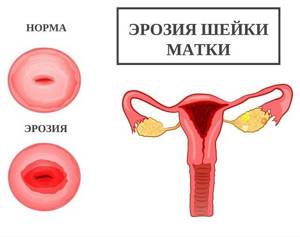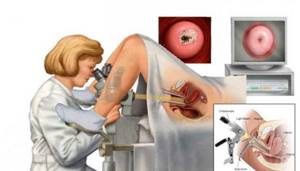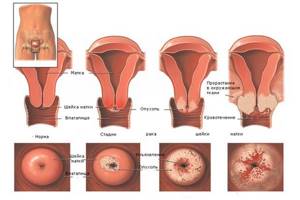What is erosion (ectopia) of the cervix?
Doctors today call cervical erosion ectopia. Ektopos translated from Greek means “displaced.” The displacement of the cell layer, in general, is the essence of erosion. Normally, the cervix is covered by two different layers of epithelium: flat - on the vaginal part of the cervix and cylindrical - in the cervical canal. The columnar epithelium sometimes moves to the vaginal surface of the cervix, taking the place of a flat layer. But “relocation” to this more aggressive environment easily injures the delicate columnar epithelium. As a result, the layer of cells is damaged, and a red, loose area appears at the entrance to the uterus - erosion.
Up
To cauterize or not?
Before answering the question regarding cauterization of cervical erosion, you must undergo a full examination by a gynecologist. No cauterization required:
- With true erosion.
- With ectopia of columnar epithelium.
- For dysplasia (also called erosion) of 1st degree.
This does not mean that nothing needs to be done. When processes are combined with a genital tract infection or hormonal disorders, conservative treatment is indicated, primarily for HPV. In the future it is recommended:
- Clinical observation for 2 years with annual colposcopy and MAC.
- Quitting alcohol and smoking.
- Adequate contraception.
- Correction of hormonal status.
In rare cases, with grade 1 dysplasia, small areas of neoplasia are treated with Vagotil. For grade 2 and 3 dysplasia, cauterization is one of the methods.
Before cauterization, it is necessary to make an accurate diagnosis. After all, most pathological changes in the cervix are asymptomatic. But sometimes you can notice a slight increase in discharge from the genital tract, discomfort during sexual intercourse and scanty bleeding after it.
Only a doctor can tell whether cauterization is required or not. No one prescribes a procedure unless absolutely necessary.
Causes of cervical erosion
In most newborn girls, under the influence of “mother’s” female hormones-estrogens, cervical ectopia is formed - and this is normal. This type of erosion is called congenital
and, as a rule, they are not treated - ectopia disappears on its own over time.
Another thing is acquired erosion. In this case, the epithelial defect occurs due to sexually transmitted infections, inflammatory diseases of the genitourinary tract, early onset of sexual activity, hormonal disorders and cervical injuries
received during childbirth, abortion and surgical procedures.
What types of erosion are there?
- Congenital erosion has such external manifestations as a certain formation on the mucous membrane of the cervix of the uterus of a round shape and bright scarlet color. This disease can appear in teenage girls, but it does not require special treatment and regresses on its own. In this case, the risk of erosion degenerating into cancer is practically absent.
- True erosion , during which a clearly defined red spot forms on the mucous membrane. The disease at this stage is almost impossible to diagnose, since it develops no more than a couple of weeks, after which it passes into the next form.
- Pseudo-erosion (ectopia) is characterized by complete replacement of single-layer epithelium with cylindrical epithelium. During a gynecological examination, the doctor may see a scarlet spot on the cervix, located at the external pharynx. This type of erosion can exist for a long time and is not able to regress on its own. It is pseudo-erosion that is considered one of the most common diseases among women of any age group.
Ectopia - is it dangerous?
On this issue, medical opinions are divided. Some experts consider ectopia to be a normal phenomenon that requires observation rather than treatment. Others remind: erosion is a good background for the development of cervical cancer
, because the main culprits of this cancer, oncogenic types of human papillomavirus, easily and deeply penetrate into the damaged surface of the cervix. Considering that every second person who is sexually active is infected with different types of HPV, the alarm is not unfounded. In addition to HPV, ectopia easily “allows in” other infections: herpes virus, mycoplasma, chlamydia, ureaplasma, etc.
Why is erosion dangerous?
Erosion itself is not dangerous. Some gynecological oncologists even recommend not removing such tissue defects, but simply monitoring them regularly. They motivate this by the fact that after excision of erosion, especially with signs of dysplasia, some of the pathological cells may hide deep in the cervical canal. Subsequently, they turn into a cancerous tumor, which is extremely difficult to diagnose in the early stages.
If all the erosion is “in sight,” then at any time you can perform a biopsy, examine the most pathological areas and identify changes in the early stages.
But in the latter case, if the erosion is not removed, it must be monitored. This means excluding inflammatory processes, regularly doing colposcopy, etc. Otherwise, erosion will gradually manifest itself as follows:
- dysplasia from mild to severe,
- leukoplakia,
- cervical cancer.

It should also be taken into account that the surface of the erosion consists of cells “without protection”, so it is much easier for any pathogen to penetrate into the deeper layers. Hence, more often against the background of erosion, papillomas, condylomas, as well as thrush and other colpitis occur.
Including a higher likelihood of contracting HIV and hepatitis, since when injured there is more and more frequent contact with blood, especially during violent sex.
Watch the video about cervical erosion:
Cervical erosion: treatment
Before treating ectopia, you need to figure out why it occurred. To do this, in addition to the tests already mentioned, you will have to take PCR swabs
for trichomonas, HPV, herpes virus, gardenerella, urea and mycoplasma, chlamydia, make
a smear “for flora”
and
bacteriological culture of the vaginal microflora
.
Plus take blood tests
for HIV, syphilis, hepatitis B and C and check if everything is okay with your hormones. If the cause of erosion is a hormonal imbalance or genital infections, treatment may be limited to drug therapy and local remedies. When conservative measures are not enough (or the ectopia reappears after treatment), surgical treatment methods are used.
Diagnostics

Even the best and most competent gynecologist, during a routine examination of the cervix in a gynecological speculum, will not be able to distinguish between true erosion, ectopia of the columnar epithelium, dysplasia, and sometimes cancer. During the examination, it is necessary to take a smear from the cervix for cytological examination (sometimes called MAC - smear for atypical cells).
But the most informative method is colposcopy - examination of the cervix through a special optical device that allows you to see the cervix under magnification. In this case, it is possible to carry out special diagnostic tests, consisting of the reaction of the epithelium to the effects of certain solutions (extended colposcopy).
Colposcopy makes it possible to take material for further research from a suspicious area (biopsy). Modern colposcopes allow you to take a photograph or examine your cervix on a monitor together with the doctor.
If changes are detected in the cervix, it is necessary to undergo a general examination, including:
- Clinical analysis of blood and urine.
- Blood test for HIV and syphilis.
- Hepatitis markers.
- Biochemical blood test with coagulogram.
- Vaginal flora smear and PCR for STDs.
More recently, “cervical erosion” was a collective term, and the doctor’s treatment tactics were based on the patient’s age and history of childbirth.
It was prescribed not to do cervical cauterization to young nulliparous women. But for those giving birth, the choice of methods for cauterizing cervical erosion varied: chemical cauterization with Vagotil or diathermocoagulation (cauterization of erosion with electric current).
Neither method was ideal. Treatment with Vagotil required several visits to the doctor or was used as an addition after cauterization of cervical erosion with electric current was done. But the main disadvantage of diatherocoagulation was cicatricial changes, which complicate subsequent births.
Cauterization of cervical erosion: how and with what?
They do everything they can with erosion: they “freeze it out” with liquid nitrogen, evaporate it with a radio wave, destroy it with a laser, burn it with electric current... And all so that in place of the destroyed cylindrical epithelium, flat epithelium “grows” again. So, what methods will help with this?
Cauterization of erosion with preparations containing organic acidsChemical coagulation - cauterization of cervical erosion with preparations with organic acids. During coagulation, a scab appears at the site of erosion, and new epithelial cells appear underneath it. After a few days, the scab peels off, but the cervical epithelium will completely recover in about 6 weeks. pros : acids do not damage the deep layers of tissue, do not leave scars on the uterus, maintaining its elasticity - a necessary condition for a successful birth. The method is well suited for nulliparous women. Minuses : Chemical coagulation is not suitable for the treatment of deep erosions. |
Cryodestruction - “freezing out” erosion with liquid nitrogenPros: the procedure is painless and is carried out free of charge in the antenatal clinic under the compulsory medical insurance policy. Minuses: long recovery. Their healing area may “ooze” lymph for a whole month, and this means discharge and an unpleasant odor. In addition, after cryodestruction, relapses of ectopia are common. |
Laser coagulation – removal of ectopia with a laser beampros : using a laser it is easy to change the depth of exposure, so the method is well suited for removing both superficial and deep erosions. Laser coagulation is painless and safe for nulliparous patients. After treatment, there are no stenoses or scars left, and healing is faster compared to other methods. Minus : Laser coagulation is an expensive procedure. |
Radio wave methodRadio wave surgery – removal of ectopia with a narrowly directed beam of radio waves. Radio waves “evaporate” water from the damaged layer of cells and destroy it. Pros: The method is well suited for nulliparous women. After the procedure, no scab or scar is formed, healing proceeds quickly. Minuses: Like laser coagulation, radio wave surgery is available mainly in private clinics and is not cheap. |
Treatment of erosion using an argon plasma torchArgon plasma coagulation is the treatment of erosion with the energy of an electromagnetic field using an argon plasma torch. The procedure is non-contact: an active electrode is applied to the site of ectopia, then a torch of argon plasma is “launched” and the affected areas on the cervix are removed with it. Pros: rapid healing and absence of scars on the cervix after treatment. Minuses : high cost of the procedure. |
Cauterization of erosion with electric currentDiathermoelectrocoagulation – cauterization of erosion with electric current. Minuses : an outdated and very traumatic method. When removing ectopia with electric current, the deep layers of uterine tissue are damaged, scars remain, and there is a risk of bleeding and stenosis of the cervical canal. Diathermoelectrocoagulation is not performed on nulliparous women. |
Ectopic cervix during pregnancyGynecologists do not recommend surgical treatment of erosion during pregnancy: the cervix will “open” worse during childbirth. In addition, ectopia, as a rule, does not affect the course of pregnancy. |
Up
Cauterize or wait
It is believed that it is prohibited for nulliparous representatives of the fair sex to cauterize erosion. The reason for this prohibition is that after the cauterization procedure, a scar remains, which prevents the cervix from opening during childbirth, as a result of which it begins to stretch poorly and tear. Therefore, all methods of treating erosion in nulliparous women should be excluded, the consequences of which may be:
- scar formation;
- severe damage to soft tissues;
- spontaneous dilation of the cervix, which during pregnancy threatens miscarriage.
Until recently, the most common method of treating erosion was cauterization with electricity, which led to all of the above consequences. That is why it does not apply to nulliparous women. But this does not mean that they do not need to treat erosion at all, since delaying therapy can lead to dangerous complications. We are talking about malignant degeneration of cells in the damaged area.
Cauterization in the traditional sense is, of course, undesirable for the cervix of a nulliparous woman. However, today there are various ways to combat erosion that are suitable for everyone, including those who have not yet become a mother.
Possible consequences
Cauterization has remained the classic treatment for cervical erosion for many years. In this case, the affected areas were cauterized using electric current. Is it possible for nulliparous girls to cauterize erosion and will this lead to any consequences? Absolutely not. Research in the field of medicine has proven that the effectiveness and safety of this method is very doubtful.
Cauterization has serious consequences for the body of a nulliparous girl, namely:
- formation of scars on the surface of the cervix;
- damage and disruption of the functioning of healthy cells;
- possible risk of subsequent miscarriages;
- fusion of the cervical canal;
- the likelihood of infertility.
The opposite situation can also happen - the walls of the cervical canal become greatly stretched due to extensive scarring and disruption of the normal structure of the cervix - as a result, isthmic-cervical insufficiency develops. This will lead to serious consequences in the future and may cause a miscarriage. And the scarring that occurs during cauterization can lead to severe ruptures and heavy bleeding during childbirth.
This does not mean that cervical erosion should not be treated. This can only aggravate the situation and lead to a number of consequences. In the future, the affected areas of the epithelium can degenerate into tumor cells, which lead to malignant formations of the cervix, namely cancer. Since cauterization of cervical erosion is strictly prohibited for nulliparous girls, there are other, more gentle treatment options.

Pregnancy after erosion
Cauterization of cervical erosion with electric current is strictly not recommended for nulliparous girls, since serious problems may subsequently arise both with conception and the course of pregnancy, and with the process of childbirth.
All other methods allow the girl to successfully become pregnant and give birth in the future. Laser treatment of affected areas of the epithelium remains the most effective and widespread method of treatment. A month after the procedure, you can start planning your pregnancy.
With cryodestruction, radio wave cauterization, laser vaporization, complete recovery occurs after 1.5-2 months, but it is best to plan a pregnancy after 4-6 months. When treating erosion with chemicals, healing occurs faster.
Treatment of erosion with chemical drugs also does not lead to the formation of scars, but its main disadvantage is the high probability of re-damage to epithelial cells. That is why this method is used only at the very initial stages of the erosion process.
Timely detection and treatment of any disease is the key to a successful and speedy recovery. Treatment of cervical erosion in nulliparous girls has its own characteristics and limitations. It is strictly forbidden to eliminate erosion by cauterization with electric current, since this method can lead to a number of serious consequences. Only safe modern methods will preserve the integrity of tissues and prevent further complications during pregnancy and childbirth.
Gentle treatment methods
Treatment of cervical erosion in nulliparous women and girls is carried out only with gentle methods, after which scars and adhesions do not form. Today there are several such methods. Which one to use is decided only by the doctor individually for each patient.
- Drug treatment. This method is appropriate for untreated erosion accompanied by inflammatory processes. This treatment is carried out immediately for both sexual partners. In this case, during treatment you should avoid sexual intercourse or be sure to use a condom.
- Cryodestruction or freezing. Treatment involves applying liquid nitrogen to the affected area. As a result, damaged cells freeze and die. In this case, healthy cells are not affected. The procedure is painless and does not cause bleeding after it is performed. There are no scars left on the cervix and it is not deformed.
- Laser therapy. The essence of the method is the direct impact of a laser beam on the affected tissue. The laser beam penetrates to the required depth and destroys the affected cells without affecting adjacent healthy tissue. The vessels are immediately welded, so rapid healing occurs, and no traces remain at the wound site. The method is highly effective and safe.
- Cauterization by radio waves. It is carried out using the Surgitron apparatus. The procedure is painless, but you may experience some bleeding for several days afterwards. You should abstain from sex for 2-3 weeks. And after 4-5 weeks, visit a gynecologist for a follow-up examination.
- Cauterization with drugs. Impact on the affected areas and destruction of diseased cells is possible with the help of drugs such as Solkovagin and Vagotil. The first drug allows you to cope with erosion in one procedure. In the second case, several procedures may be required.
Each method is aimed at destroying the affected cells, however, unlike electrocoagulation, the above methods do not entail undesirable consequences for women who are yet to become pregnant and give birth. Often, minor erosion at the initial stage is only observed by a gynecologist before treatment is prescribed.
It should be remembered that there are no universal methods for treating erosion, especially in nulliparous women. Only a doctor can assess her character and prescribe the most appropriate treatment with minimal consequences for the patient.
In any case, you cannot ignore the condition of the cervix without attention and let the disease take its course. Over time, it progresses and can lead to unwanted dangerous consequences. Therefore, you should regularly visit your gynecologist for a routine examination, even if nothing bothers you.
Safe treatments
All types of elimination of erosive processes in nulliparous girls must meet several important requirements: a gentle effect on the tissue, minimal consequences and the absence of scars or adhesions.
Taking medications. This method is used only in the earliest stages of cell damage to eliminate the source of inflammation. If erosion is caused by various infections, then the doctor may prescribe drugs to destroy pathogenic microorganisms. Also, the use of suppositories or ointments may be prescribed as topical medications. The complex action of these agents enhances the regeneration of the epithelium and also significantly accelerates the healing process. Antiseptic suppositories, antibiotics, antiviral agents, immunomodulators, suppositories and ointments with healing components are used.
Laser therapy. The essence of this method is the direct impact of laser beams on the affected area of the epithelium. Is it possible to cauterize erosion in nulliparous girls in this way? Yes, you can. One of the main advantages of this method is that the laser penetrates only the affected areas and does not affect healthy areas at all. In addition, there are no scars or bleeding wounds left at the site of laser cauterization, and healing occurs much faster than with other methods. Thus, after cauterizing cells with a laser, there are no serious consequences.
Action by radio waves. The method is highly effective, non-invasive and provides rapid healing. The recovery process lasts 1 – 2 months. Immediately after the procedure, slight bleeding may occur. You should refrain from sexual intercourse for 15-20 days, and a month after cauterization, be sure to visit a gynecologist.
Cryodestruction. The affected areas of the epithelium are treated with liquid nitrogen, which has a freezing effect. As a result, areas of affected tissue die, while healthy cells remain intact. It is considered one of the best ways to treat erosion, since the action of liquid nitrogen does not cause scarring or deformation of healthy tissue.
Cauterization with drugs. In this case, local drugs are used, for example, Solkovagin and Vagotil. These products can remove eroded areas in one procedure without compromising the integrity of healthy tissue.
All of the above methods are excellent for removing cervical erosion in nulliparous girls. Their main difference from electric cauterization is the absence of consequences, as well as the preservation of all healthy cells and tissues, which is a necessary condition for the successful course of pregnancy and childbirth.










